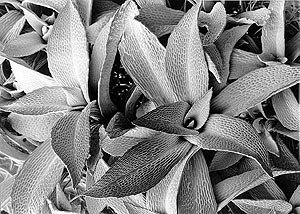WALNUT CREEK, CA–Messages from nearly a half-billion years ago, conveyed via the inventory of genes sequenced from a present-day moss, provide clues about the earliest colonization of dry land by plants. The U.S. Department of Energy Joint Genome Institute (JGI) was among the leaders of an international effort uniting more than 40 institutions to complete the first genome sequencing project of a nonvascular land plant, the moss Physcomitrella patens. The team’s insights into the code that enabled this seminal emergence and dominance of land by plants are published December 13 online in Science Express.

Scanning electron micrograph of Physcomitrella patens gametophores (moss shoots). Courtesy of John Doonan, The John Innes Centre, Norwich, UK.
The moss genome project, originally proposed by Brent Mishler of the University of California, Berkeley, and Ralph Quatrano of Washington University in St. Louis (WUSTL), was enabled through the JGI’s Community Sequencing Program (CSP). Other project leaders include JGI’s Jeffrey Boore, David Cove and Andrew Cuming of the University of Leeds (United Kingdom), Mitsuyasu Hasebe and Tomoaki Nishiyama of the National Institute for Basic Biology (Japan), and Ralf Reski of the University of Freiburg (Germany) with his associate Stefan Rensing, the paper’s first author.
“Physcomitrella is to flowering plants what the fruit fly is to humans; that is, in the same way that the fly and mouse have informed animal biology, the genome of this moss will advance our exploration of plant genes and their functions and utility,” said Eddy Rubin, JGI Director. “Traits such as those that allow plants to survive and thrive on dry land will be useful in the selection and optimization of crops that may be domesticated for biomass-to-biofuels strategies.”
Physcomitrella, with a genome of just under 500 million nucleotides and possessing nearly 36,000 genes (about 50% more than are thought to be in the human genome), is the first bryophyte to be sequenced. Bryophytes are nonvascular land plants that lack specialized tissues (phloem or xylem) for circulating fluids. Rather, they possess specialized tissues for internal transport. They neither flower nor produce seeds but reproduce via spores.
“The availability of the Physcomitrella genome is expected to create important new opportunities for understanding the molecular mechanisms involved in plant cell wall synthesis and assembly,” said Chris Somerville, Director of the Energy Biosciences Institute (EBI), the partnership between Lawrence Berkeley National Laboratory, U.C. Berkeley, the University of Illinois at Urbana-Champaign, and the global energy company BP. “The ease with which genes can be experimentally modified in Physcomitrella will facilitate a wide range of studies of the cell wall, the principal component of terrestrial biomass. Additionally, the moss has fewer cell types than higher plants and has a much more rapid lifecycle, which also greatly facilitates experimental studies of cell walls. Thus, the completion of the genome is an important step forward in facilitating basic research concerning the development of cellulosic biofuels.”
“There is a clear connection with this work and the intensifying interest in the global carbon cycle,” said Mishler, a U.C Berkeley Professor in the Department of Integrative Biology and Director of the University and Jepson Herbaria. “The moss system is proving quite useful for studies of photosynthesis among many other processes.”
One of these, said Quatrano, who is Chairman of the Department of Biology at WUSTL, “is the ability of mosses to withstand drought and in some cases complete desiccation, which will provide us with a model experimental system to identify genes and gene networks that might be involved and related to seed desiccation in flowering plants.”
Mishler said that Physcomitrella is well placed phylogenetically to fill in the large gap between the unicellular green alga Chlamydomonas, also sequenced by JGI, and the flowering plants.
“Having the full Physcomitrella genome available to the public greatly advances bioinformatic comparisons and functional genomics in plants,” said Mishler. “This is a great example of how phylogenetics can integrate with functional and applied studies.”
“Furthermore,” Quatrano said, “unlike vascular plant systems, we can target and delete specific moss genes to study their function in important crop processes, and replace them with genes from crop plants to allow us to study the evolution of gene function. In addition to the genome, extensive genomic tools are now available in Physcomitrella to study comparative gene function and evolution as related to bioenergy and other processes of importance to crops.” These tools can be found at: www.mossgenome.org.
The JGI’s Community Sequencing Program (CSP) provides the scientific community at large with access to high-throughput sequencing by JGI for projects of relevance to DOE missions in bioenergy, carbon cycling, and bioremediation. Sequencing projects are chosen based on scientific merit judged through independent peer review. Currently, letters of intent for CSP FY2009 sequencing allocation are being solicited. More information can be found at http://www.jgi.doe.gov/CSP/index.html
Other JGI authors on the study include Astrid Terry, Asaf Salamov, Harris Shapiro, Erika Lindquist, Hank Tu, Susan Lucas, and Igor Grigoriev.
The U.S. Department of Energy Joint Genome Institute, supported by the DOE Office of Science, unites the expertise of five national laboratories–Lawrence Berkeley, Lawrence Livermore, Los Alamos, Oak Ridge, and Pacific Northwest–along with the Stanford Human Genome Center to advance genomics in support of the DOE missions related to clean energy generation and environmental characterization and cleanup. The JGI’s Walnut Creek, CA, Production Genomics Facility provides integrated high-throughput sequencing and computational analysis that enable systems-based scientific approaches to these challenges.